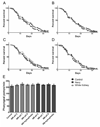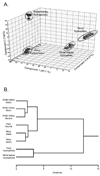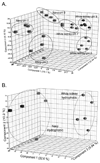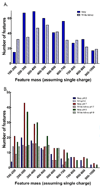Characterization of low molecular weight chemical fractions of dry bean (Phaseolus vulgaris) for bioactivity using Caenorhabditis elegans longevity and metabolite fingerprinting
- PMID: 20455573
- PMCID: PMC2884184
- DOI: 10.1021/jf1007538
Characterization of low molecular weight chemical fractions of dry bean (Phaseolus vulgaris) for bioactivity using Caenorhabditis elegans longevity and metabolite fingerprinting
Abstract
Dry bean consumption has been reported to be associated with reduced risk for a number of chronic diseases including cancer. The extent to which these benefits are associated with primary versus secondary plant metabolites is not known. The work reported herein focuses on low molecular weight secondary metabolites and uses longevity extension of wild-type Caenorhabditis elegans nematodes as a surrogate marker for human health benefits. A modified Bligh and Dyer technique was used to extract freeze-dried bean, and the resulting fractions were evaluated for longevity extension and metabolite fingerprinting using ultra performance liquid chromatography-mass spectrometry (UPLC-MS). Dry bean extracts extended adult C. elegans lifespan by as much as 16%. Hydrophilic fractions increased lifespan, whereas the hydrophobic fraction induced longevity reduction. Metabolite fingerprinting revealed distinguishing spectral differences among the four chemical fractions evaluated and demonstrated that within each fraction chemical composition differed significantly based on dry bean genetic heritage.
Figures






Similar articles
-
Calycophyllum spruceanum (Benth.), the Amazonian "Tree of Youth" Prolongs Longevity and Enhances Stress Resistance in Caenorhabditis elegans.Molecules. 2018 Feb 27;23(3):534. doi: 10.3390/molecules23030534. Molecules. 2018. PMID: 29495517 Free PMC article.
-
Unlocking the Potential of Curcumae Rhizoma Aqueous Extract in Stress Resistance and Extending Lifespan in Caenorhabditis elegans.Molecules. 2025 Apr 8;30(8):1668. doi: 10.3390/molecules30081668. Molecules. 2025. PMID: 40333562 Free PMC article.
-
A transfer-less, multi-well liquid culture feeding system for screening small molecules that affect the longevity of Caenorhabditis elegans.Biotechniques. 2009 Dec;47(6 Suppl):ix-xv. doi: 10.2144/000113277. Biotechniques. 2009. PMID: 20041852
-
Longevity promoting efficacies of different plant extracts in lower model organisms.Mech Ageing Dev. 2018 Apr;171:47-57. doi: 10.1016/j.mad.2018.03.002. Epub 2018 Mar 8. Mech Ageing Dev. 2018. PMID: 29526449 Review.
-
Bioactive Phytochemicals with Anti-Aging and Lifespan Extending Potentials in Caenorhabditis elegans.Molecules. 2021 Dec 2;26(23):7323. doi: 10.3390/molecules26237323. Molecules. 2021. PMID: 34885907 Free PMC article. Review.
Cited by
-
Dietary Bean Consumption and Human Health.Nutrients. 2019 Dec 17;11(12):3074. doi: 10.3390/nu11123074. Nutrients. 2019. PMID: 31861044 Free PMC article.
-
Metabolite profiling of a diverse collection of wheat lines using ultraperformance liquid chromatography coupled with time-of-flight mass spectrometry.PLoS One. 2012;7(8):e44179. doi: 10.1371/journal.pone.0044179. Epub 2012 Aug 30. PLoS One. 2012. PMID: 22957002 Free PMC article.
References
-
- Broughton WJ, Hernandez G, Blair M, Beebe S, Gepts P, Vanderleyden J. Beans (Phaseolus spp.) - model food legumes. Plant and Soil. 2003;252(1):55–128.
-
- Correa P. Epidemiological correlations between diet and cancer frequency. Cancer Res. 1981;41(9 Pt 2):3685–3690. - PubMed
-
- Adebamowo CA, Cho E, Sampson L, Katan MB, Spiegelman D, Willett WC, Holmes MD. Dietary flavonols and flavonol-rich foods intake and the risk of breast cancer. Int. J. Cancer. 2005;114(4):628–633. - PubMed
-
- Mills PK, Beeson WL, Phillips RL, Fraser GE. Cohort study of diet, lifestyle, and prostate cancer in Adventist men. Cancer. 1989;64(3):598–604. - PubMed
Publication types
MeSH terms
Substances
Grants and funding
LinkOut - more resources
Full Text Sources

